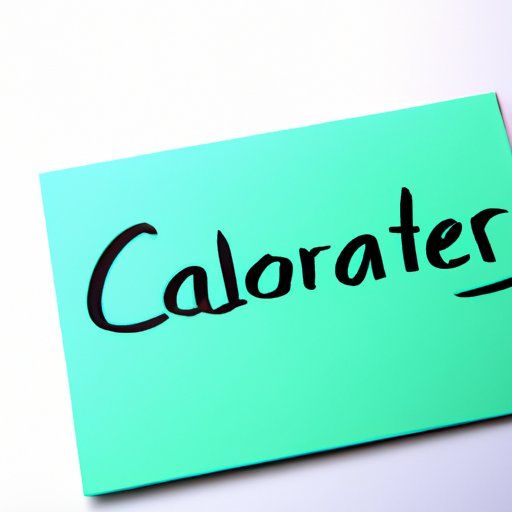
Introduction
Are you struggling to lose weight despite counting calories and exercising regularly? Perhaps you’re not in a calorie deficit, a state where you burn more calories than you consume. The only way to lose weight is by consistently being in a calorie deficit. But how do you achieve this without starving yourself? Here are six topics that this article will cover to help you meet your goals:
Understanding Caloric Deficit
What exactly is a calorie deficit, and why is it essential for weight loss? A calorie deficit simply means burning more calories than you consume daily. It’s the only way to lose body fat and improve your body composition. The concept of calories in versus calories out is essential to understand here. If you consume more calories than you burn, you’ll gain weight. However, if you burn more calories than you consume, you’ll lose weight. Knowing how many calories your body needs is the key to creating a calorie deficit. To do this, you need to calculate your total daily energy expenditure, which includes your resting metabolic rate and activity level.
Macronutrients Protein, carbohydrates, and fats are macronutrients that provide energy to your body. Each macronutrient has a different number of calories per gram, with protein and carbohydrates having four calories per gram and fat containing nine calories per gram. By tracking macronutrient intake, you can ensure that you get enough of each one while also being in a calorie deficit.
Healthy Caloric Deficit Diet Plan
Reducing calorie intake doesn’t mean you have to compromise on health. Here are some tips for maintaining a healthy diet plan while in a calorie deficit:
1. Make healthy food choices: Choose nutrient-dense foods like vegetables, fruits, lean proteins, and whole grains.
2. Practice portion control: Use a food scale or measuring cups to monitor portion sizes.
3. Cook meals at home: Prepare your meals using fresh and whole ingredients.
4. Meal planning: Plan your meals ahead of time to avoid impulsive decisions.
5. Limit sugar and processed foods: Avoid foods that are high in calories but offer little nutritional value.
Here are some meal plans examples, depending on your daily caloric intake:
1. 1200 calories: Breakfast- oatmeal with fruits and nuts, Lunch- chicken and veggie stir fry, Dinner- lentil soup with a garden salad.
2. 1500 calories: Breakfast – whole grain toast with avocado and an egg, Lunch- turkey sandwich with veggies and hummus, Dinner- salmon with quinoa and steamed veggies.
3. 1800 calories: Breakfast- protein smoothie with spinach, Lunch- turkey chili with whole grain bread, Dinner- zucchini noodles with chicken and marinara sauce
Caloric Deficit Workout Guide
Exercising during a calorie deficit can help with weight loss as well as muscle preservation. Here are some tips on choosing the best workout for your goals:
1. Choose the right workout: A combination of cardio and strength training is an excellent way to lose weight and maintain muscle mass.
2. Switch it up: Change your workout routine regularly to avoid plateaus.
3. Do compound exercises: Compound exercises engage several muscle groups at once and burn more calories.
4. High-intensity interval training (HIIT): HIIT workouts are effective at burning calories and increasing metabolism.
Here are some examples of exercises for cardio and strength training:
1. Cardio: Running, biking, jumping jacks, and rowing machines are all great options for burning calories.
2. Strength training: Squats, lunges, deadlifts, and bench press are excellent exercises for building strength and tone muscle.
Tracking Your Progress
Measuring your progress is essential to sustaining weight loss. Here are some tips:
1. Food journal: Keep a journal of your food and calorie intake to stay accountable to your goals.
2. Exercise Log: Log your workouts, including sets, reps, and weight used to monitor progress.
3. Body composition: Use tape measures or calipers to measure your body fat and lean muscle mass.
The Importance of Rest and Recovery
Rest and recovery are often overlooked, but they’re critical for overall health and weight loss. Here are some tips:
1. Get enough sleep: Aim for 7-9 hours of sleep per night to allow your body to recover.
2. Incorporate active recovery: Yoga, swimming, and walking are great options for active recovery.
3. Take rest days: Schedule days off to allow your body to rest and heal.
Staying Motivated
Measuring progress can be challenging, but staying motivated is essential. Here are some tips:
1. Set realistic goals: Create achievable goals that inspire you to stay motivated.
2. Workout buddy: Find a friend or exercise partner to keep you accountable.
3. Rewards Systems: Set up a reward system that motivates you to continue achieving your goals.
4. Apps: Use helpful apps like MyFitnessPal and Fitbit to track progress.
Conclusion
To maintain a healthy weight, being in a calorie deficit is critical. However, it’s essential to practice safe and sustainable weight loss methods while achieving this goal. By learning healthy habits, incorporating regular exercise, tracking progress, practicing rest and recovery, and staying motivated, you will achieve sustainable weight loss and maintain healthy habits for the long term.





